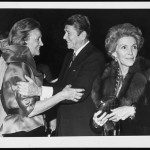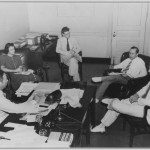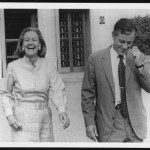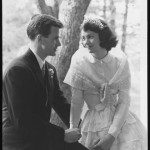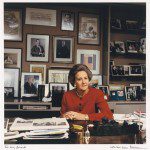“One life: Katharine Graham” at the National Portrait Gallery
By • July 26, 2011 0 3427
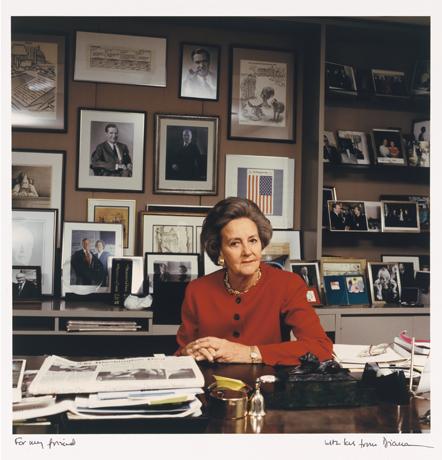
That small room in the National Portrait Gallery housing “One Life”, the series of exhibitions begun since the completed renovation of the Reynolds Center, may be one of the biggest rooms in the whole building. “One Life”, after all, attempts to squeeze into a small, square room a summation of an entire American life with a minimum of artifacts, paintings and photographs. Not an easy task when you’re dealing with the previous tenants.
There was Walt Whitman, the outsized poet of the outsized American experience; Thomas Paine, the inspiring, iconoclastic political pamphleteer of inspiration for the American revolution; there was most recently Elvis Presley, king of rock and roll, an entire American cultural invention unto himself.
There was Abraham Lincoln. No one sentence would suffice.
There was the first Katharine, the grand dame and Dame of American movies, Katharine Hepburn, or Katharine the Great.
And there is today the other Katharine, Katharine Graham, the publisher of the Washington Post, who made the Post one of the truly great newspapers of the world in what may arguably have been the last golden age, the Indian summer of the newspaper business.
Probably no previous subject of the “One Life” series means quite so much to the current residents of this city as this one – even Lincoln or Elvis. Katharine Graham, as a prominent figure, as a publisher of a national newspaper, as a deeply powerful and influential national and international figure, rose to real prominence in 1963 when she became the publisher of the Washington Post after the shocking and tragic suicide of her husband Phil Graham. At sea in a role she never anticipated, even though she grew up in the world of the Post her father had bought in the 1930s, she learned quickly and adapted, overcame painful shyness, and in a unique partnership with Managing Editor Ben Bradlee, guided the paper in short order through the risky and courageous business of printing the Pentagon Papers (though the New York Times fell into the same category), exploding Watergate onto the front pages of a major newspaper, and afterwards, surviving an almost ruinous printers’ strike in the 1970s.
She was, as it turned out, tough.
That’s certainly the impression you get from the first photograph you see upon entering the exhibition – the famous, iconic, dramatic, almost forbidding black and white portrait taken by Richard Avedon in March of 1976.
She stares at the camera sternly, challengingly, even quizzically. Her arms are folded. Her mind appears made up about something. She has, for want of a better word, a certain gravitas there, earned honestly and with great difficulty in a world completely dominated by men, even in the ‘70s.
It’s not an entirely inviting image to an exhibition, but it takes care of summing up Graham as, by that time and certainly for the rest of her life, one of the most powerful women—people—in the world.
“It’s not something you could leave out,” says Curator Amy Henderson, who normally organizes exhibitions on popular culture icons like…say, the other Katharine, Katharine Hepburn. “The image
is iconic, and it shows that toughness, that courage which let her accomplish what she did. It’s a way in. But we wanted to do a lot more. We wanted to show a little bit of what made Katharine Graham the woman and person she became.”
The “We” Henderson refers to was a notable duo of consultants who knew Graham intimately. Pie Friendly, a researcher at the National Portrait Gallery, knew Graham socially through her husband
and father-in-law, journalist and writer Alfred Friendly Jr., and former Post Managing Editor Al Friendly, respectively. Liz Hylton, Graham’s personal assistant, provided access to photos and memorabilia and anecdotal material. “It was just us three ladies,” Henderson said. “The Washington Post and the Graham family were tremendously helpful.”
“We all knew each other,” Friendly said. “You would always cross paths through the paper, schools, parties and social occasions. I respected and admired her tremendously. She was a woman in a man’s world, truly. She was straight forward, honest. You cannot imagine what it must have been like for her, but she did more than persevere. She made the Post a great newspaper. It was just tremendous fun working on this, it really was. And mind you, she fired my father-in-law and replaced him with Ben Bradlee.”
Henderson was obviously limited in terms of space, so there’s a lot more that could have found its way into a larger exhibition. But what resides tells her story, fleshes her out, and portrays Graham
in full.
“It’s interesting going through these photographs—of which there were a lot,” Henderson said. “You get a sense of a woman, a girl, who was raised in a privileged world, was raised in her father’s newspaper business [working as a reporter]…who met and married a man she absolutely adored, and wanted nothing more than to be a wife, a mother, raise her children and do good deeds, and perhaps be a social leader. She never expected to be what she became. It required reinvention of the most difficult sort.”
When Henderson talks about Graham—whom she never met, she will tell you—certain words recur with regularity, as they do when you talk with Pie Friendly: “forthrightness, honesty, integrity, courage, resilience.” These are, of course, all qualities that elicit great admiration, without necessarily revealin a human being so much as a statue.
The pictures and artifacts, carefully selected by the trio of women, accomplish that job, even if the two videos (for the NPG’s Living History series by former director Mark Pachter) in which Graham talks about Watergate and the Pentagon Papers don’t entirely do so. There are many pictures, for instance, in which some form of the Graham sternness of the Avedon image are repeated: Graham with her editors, Graham at a meeting of the Associated Press National Board, Graham unsmiling in lots of photos.
But there are also a lot of portraits of Graham smiling, laughing with her head thrown back, and the smile and laugh show a woman transformed: a fun loving person in the moment. It’s a pretty dazzling smile she’s got there. And not one easy to acquire given the charismatic but self-absorbed nature of the dazzling Agnes Ernst Meyer, her mother, shown in a haunting photograph taken by no less a photographer than Edward Steichen. Her father, Eugene Meyer, while he encouraged and obviously loved his daughter, was rarely accessible and often distant. And there was the kinetic, hypnotic Phil Graham, who became publisher of the Post and absolutely swept Katharine away, until his instability began to overtake him.
What did she achieve? Take a look at the AP meeting portrait: a semi-circular made up entirely
of men who look somewhat like the cast of “Mad Men” in late middle age, minus cocktail
and cigarettes. And there is Graham, alone as a woman, but uncommonly self-assured. In her memoir, she wrote that she accepted life in a man’s world but then ended up leading a change in that world.
Watergate and the Pentagon Papers, and the Post’s growing reputation as a writer and reporter’s paper under Graham’s leadership, steered the paper into a stratosphere occupied by few publications.
Both the Pentagon Paper publication and, even more so Watergate, were dangerous times for the Post, but also thrilling and memorable times. In a way, the Post helped bring down a president, and the movie version of the Woodward-Bernstein saga “All The President’s Men” did not change that perception. Graham herself began to become an influential social lioness, and you can see her light up like a Christmas tree with Jacqueline Kennedy in New York, and at the black and white ball thrown by Truman Capote in her honor.
The infamous—therefore treasured—showdown with then-Attorney General John Mitchell, in which he blustered that Kate had gotten her tit in a wringer, resulted in a gift of a miniature wringer and small jeweled replicas of a wringer and a breast, which she wore proudly and with grand humor. They are among the artifacts on view, which also include the first hand-written page of her Pulitzer Prize-winning
memoir and the mask she wore to Truman Capote’s black and white ball.
The strike was difficult for Graham and in squashing the union she acquired, unfairly said a Post reporter, a reputation for ruthlessness. “Not so, not so,” said Robert Kaiser, who wrote the official story on the strike for the Post, “without any interference from her.”
“That was undeserved. She was the ideal publisher if you were a reporter.”
For most of us who were not Posties, the paper nevertheless was a daily presence in its headiest period, and Graham, for Georgetowners, living in her mansion, was an uncrowned queen. When she passed away, the funeral at the National Cathedral and subsequent wake at her home seemed like one last gathering for which she had called upon the world to come. And the world came.
The exhibition, which gets all the right things in that small room, seems particularly poignant in a time when the idea of great newspapers seems more memory, and a memory without a future at that. You feel almost glad that she’s not here to see the confusion and decline and predicted disappearance of newspapers in the 21st Century.
On the other hand, she might have found a way to prevent all that, to persevere. That Avedon picture, that look, those crossed arms seem to indicate that she just might have done it.
- Graham at her desk at the Washington Post | Courtesy of NPG


